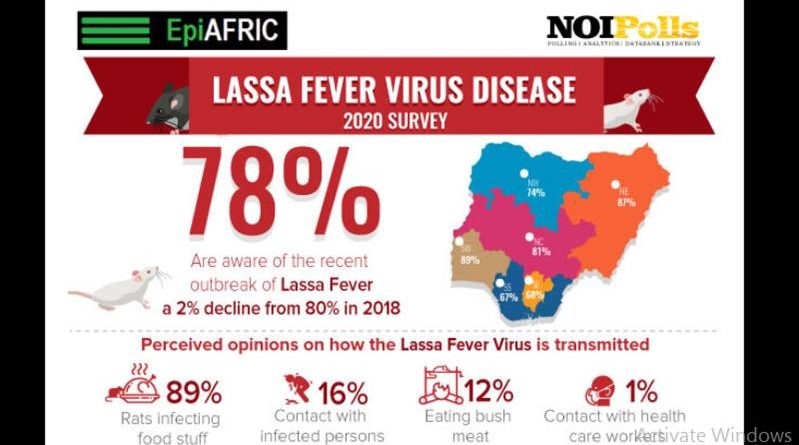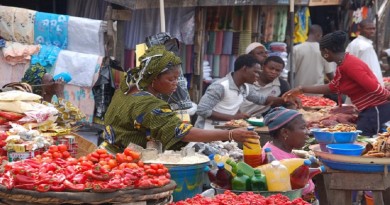Nigerians Maintain a High Awareness of Lassa Fever Disease in 2020 – NOIPolls
In 2016 and 2018, NOIPolls in partnership with EpiAFRIC conducted an opinion poll to seek the perceptions of Nigerians regarding the awareness of, mode of transmission of, symptoms of and awareness on possible preventive measures for Lassa Fever. The poll was repeated in 2020 and showed that a high level of awareness about the outbreak in the country was maintained though with 2 percent drop when compared to the 2018 survey.
The poll result revealed that there is a high level of Lassa Fever disease awareness amongst Nigerians and awareness is highest in the South-West (89 percent) and North-East zones (87 percent) of the country. The poll also showed that this awareness is commonly driven through radio (50 percent), television (31 percent), word of mouth (22 percent), Social media (20 percent) and newspapers (8 percent). With regards to transmission, rat infected food stuff is generally believed to be the main mode of transmission, while some identified fever (44 percent), headache (35 percent), mucosal bleeding (14 percent) and vomiting (12 percent) to be among the symptoms of the disease.
Further findings revealed that respondents (44 percent) maintained that keeping their houses clean especially the kitchen is one of the ways in which they can avoid being infected by the virus. While majority of the Nigerians (95 percent) indicated that they are willing to go to public hospital or health care if affected by the disease, 59 percent of Nigerians also expressed their confidence with their local hospital to be able to manage cases of Lassa Fever in the country. Lastly, 83 percent of the respondents admitted that the Ministry of Health has being carrying out enough sensitization about the disease across the country. These are some of the key findings from the Lassa fever poll conducted in the week commencing February 17th, 2020.
Survey Background
Lassa fever is a severe and often deadly virus-related illness, with fever, caused by Lassa virus and happening predominantly in West Africa. It is also known as Lassa Hemorrhagic Fever (LHF) and is typically acquired from infected rodents. Research has shown that it is prevalent during the dry season. Lassa fever was first discovered originally in 1969 in Lassa, a remote village in Borno State, Nigeria and since then, there have been numerous outbursts of different level and severity across West Africa.
A yearly assessment of this deadly disease revealed as much as 5, 000 deaths and 300, 000 infections across West Africa, yet, lack of resources to detect the illness on time, insufficient data and inadequate surveillance had resulted in several other cases not accounted for.[1] The World health Organization describes Lassa fever as endemic in Nigeria and the annual peak of human cases is usually observed during the dry season (December–April). This follows the reproduction cycle of the Mastomys species of rats in the wet season (May – June).
Recently, response to Lassa fever has improved in Nigeria, led by the Nigeria Centre for Disease Control (NCDC). NCDC has done so much work to prevent and respond to Lassa fever at the national level. However, it is imperative that states and local governments take responsibility to sustain the work of the NCDC in their respective locations. NCDC activated a National Emergency Operations Centre (EOC) with an inter-disciplinary, multi-partner technical team to ensure a well-coordinated response and swift control of Lassa fever outbreaks across affected states. Confirmed cases are being treated in the designated treatment centers in the affected states following optimized standard of care protocols. Guidelines for appropriate case management and infection prevention and control (IPC) measures have been disseminated to the different states.
While Nigeria is a Lassa fever endemic country and the NCDC has developed capacity for managing Lassa fever outbreaks, the current overall risk is considered moderate at national level. However, risks exist mostly due to socio-cultural practice in food management and lack of proper hygiene. Prevention of Lassa fever relies on promoting good “community hygiene” to discourage rodents from entering homes. Effective measures include storing grain and other foodstuffs in rodent-proof containers, disposing of garbage far from the home, and maintaining clean households. Given this background, NOIPolls in partnership with EpiAfric conducted a recent poll to seek the perceptions of Nigerians regarding the awareness, mode of transmission, symptoms and to ascertain their awareness on possible preventive measures of Lassa Fever.
Survey Findings
The 2020 survey shows that 78 percent of the respondents were aware of the recent outbreak of Lassa Fever Virus in the country. In the 2018 survey, respondents’ level of awareness on the Lassa Fever outbreak was 80 percent, while 2016 report showed that 81 percent awareness. This means that there has been a total 3 percent decrease in level of awareness since 2016
Further analysis indicates that in 2020, North-East, North-central and North-east zones had higher levels of awareness of the outbreak of Lassa Fever disease. However, while the south west zone had the highest score of 89 percent, the south-south and south east zones showed the lowest level of awareness at 67 percent and 68 percent respectively, despite being among zones with most cases of Lassa fever.
Past survey shows very similar levels of awareness across age distribution. However, the 2020 poll shows more people above 60 years of age are aware of the disease compared to youths aged between 18 and 35 years. Nationwide, there has been a 3 percent point decrease in awareness since the 2016.

During the survey, it was important to note the respondents’ source of awareness. The 2020 survey results indicate that, when the question “How did you hear about the outbreak of Lassa Fever disease?” was asked, ‘radio’ (50 percent) topped the list of sources of awareness and ‘television’ was second with 31 percent.
In comparison with past polls, there is a steady increase for radio from 39 percent in 2016. Social media also increased by 9 percent (from 11 percent at the 2018 to 20 percent in the 2020). It further indicates a decline in information dissemination from TV by 16 percent between 2016 and 2020 polls.

The survey sought to assess respondents’ knowledge on the modes of transmission of Lassa fever. Nationwide, the mode of transmission with the highest value cited by participants was ‘rat infected food stuff’ (which is 9 percent more than the 2018 survey results). Across gender, geo-political zones and age groups, this was the most widely held opinion; 12 percent of respondents indicated that Lassa fever virus is transmitted by ‘eating bush meat’ (4 percent more than indicated in the 2018 poll).

Symptoms of Lassa fever mimic those of malaria, therefore it is important to know these similarities in symptoms. To determine their level of awareness, respondents were asked to identify symptoms exhibited by Lassa Fever patients. Findings from the survey revealed that 44 percent of respondents identified fever as a symptom of Lassa fever (a massive 22 percent decrease from 2018 poll). Thirty-five percent of respondents identified headache as a symptom of Lassa fever, 3 percent identified chest pain as a symptom of Lassa fever, 2 percent identified facial swelling as a symptom of Lassa fever. Other symptoms the respondents mentioned were sore throat (8 percent), chest pain (3 percent) and back pain (5 percent) and facial swelling (2 percent).

Furthermore, the survey also sought to assess respondents’ knowledge of the preventive measures people can take to avoid being infected. Respondents were asked ‘what preventive measures would you take to avoid being infected by the virus?’. Forty-four percent of respondents identified “keep the house clean especially the kitchen” as a preventive measure to take to avoid being infected by a virus. In contrast, 7 percent of respondents identified “block all rat hideouts” as a preventive measure to take to avoid being infected by a virus.

Findings form the survey revealed that 95 percent of respondents would be willing to go to a public hospital/primary health centre if they were infected by the disease.
Findings from the survey revealed in 2016 and 2018 that 92 percent of respondents would be willing to go to a public hospital/primary health center if they were infected by the disease. However, in 2020, 95 percent of respondents would be willing to go to a public hospital/primary health center if they were infected by the disease. This shows a 3 percent-point increase in health-seeking behaviors.

Findings from the survey revealed that 83 percent of respondents believe that the Ministry of Health carried out enough sensitization on Lassa fever.
Trend analysis shows that 83 percent of respondents in 2016 believe that the Ministry of Health carried out enough sensitization on Lassa fever. However, that reduced in the 2018 and increased again to 83 percent in the 2020 poll.

In conclusion, the survey has shown that the level of awareness of the outbreak has seen a general 3 percent reduction nationwide. From 1 January through 9 February 2020, 472 laboratory confirmed cases including 70 deaths (case fatality ratio= 14.8 percent) have been reported in 26 out of 36 Nigerian states and the Federal Capital Territory. Of the 472 confirmed cases, 75 percent have been reported from three states: Edo (167 cases), Ondo (156 cases) and Ebonyi (30 cases). The poll findings show that the South-South and south-East zones had lowest level of awareness at 67 percent and 68 percent respectively, despite being amongst the zones with the most cases of Lassa fever.
Furthermore, radio still tops the list as the most common source of information for Lassa fever disease. The Lassa fever 2020 survey results showed that 50 percent of the respondents selected ‘radio’ as their main channel of awareness. However, every channel of communication must be maximized in order to reach as many people as possible. With the increase in the use of social media and increasing internet penetration, the 2020 poll saw an increase in these platforms by 9 percent.
Although, Lassa fever polls from 2016 through 2018 and 2020 indicate high levels of awareness of Lassa Fever, as well as awareness of modes of transmission and good knowledge of what to do to prevent the disease. However, the underling behavioral issues haven’t been addressed. Foodstuff are still dried in the open and people still exhibit poor attitudes to refuse disposal. Perhaps a liaison between health and agencies that improve environmental wellbeing at community levels may drive behavioral change.
Finally, the polls showed about 59 percent confidence in the health care system – 11 percent drop in confidence from 2016 polls. However, respondents demonstrated high levels of willingness to see care at hospitals when infected by the disease. Healthcare workers have been urged to always adopt the test and treat practices especially for malaria and to maintain a high index of suspicion in managing suspected Lassa fever. Further, health workers should also practice adequate infection prevention and control (IPC) measures in managing all patients.
Survey Methods
The poll was conducted in the week commencing February 17, 2020. It involved telephone interviews of a proportionate nationwide sample of 1,000 randomly selected phone-owning Nigerians aged 18 years and above, representing the six geo-political regions and 36 states and the FCT of the country. Interviews were conducted in 5 languages – Igbo, Hausa, Yoruba, Pidgin English and English. With this sample size and selection, we are 95% confident that the results obtained are statistically precise within a margin of error of plus or minus 4.65%.
We recognize that the exclusive use of telephone polling has its limitation of excluding non-phone-owning Nigerians. Nonetheless, with the country’s tele density put over 100 percent by the Nigerian Communications Commission (NCC), we consider our telephone polling approach appropriate. Also, given the rigorous scientific process of randomization and stratification applied, we are confident of the validity of our methodology and approach. NOIPolls Limited, No1 for country specific polling services in West Africa. We conduct periodic opinion polls and studies on various socio-economic and political issues in Nigeria. More information is available at www.noi-polls.com.
This press release has been produced by NOIPolls Limited to provide information on all issues which form the subject matter of the document. Kindly note that while we are willing to share results from our polls with the general public, we only request that NOIPolls be acknowledged as author whenever and wherever our poll results are used, cited or published.
NOIPolls hereby certifies that all the views expressed in this document accurately reflect its views of respondents surveyed for the poll, and background information is based on information from various sources that it believes are reliable; however, no representation is made that it is accurate or complete. Whilst reasonable care has been taken in preparing this document, no responsibility or liability is accepted for errors or fact or for any views expressed herein by NOIPolls for actions taken as a result of information provided in this report. Any ratings, forecasts, estimates, opinions or views herein constitute a judgment as at the date of this document. If the date of this document is not current, the views and content may not reflect NOIPolls’ current findings and/or thinking.




